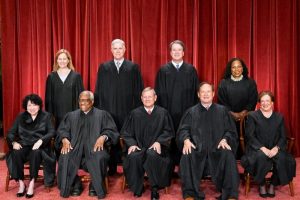
Takeaways from the Supreme Court arguments over whether Trump is ineligible to be president again
By Nicholas Riccardi, Associated Press
WASHINGTON (AP) — The Supreme Court on Thursday heard two hours of historic arguments in a Colorado case to remove former President Donald Trump from the ballot. The justices sounded highly skeptical of the effort.
It’s the first time that voters have tried to block a candidate from the presidency under a once-obscure post-Civil War constitutional provision barring those who “engaged in insurrection” from holding office.
Colorado Secretary of State Jena Griswold speaks in front of the U.S. Supreme Court, Thursday, Feb. 8, 2024, in Washington. The U.S. Supreme Court on Thursday will take up a historic case that could decide whether Donald Trump is ineligible for the 2024 ballot under Section 3 of the 14th Amendment. (AP Photo/Manuel Balce Ceneta)
Some takeaways from the arguments:
TRUMP SEEMS LIKELY STAY ON THE BALLOT
In tone and tenor, the justices’ questions challenged the notion that a state court can order a presidential contender off the ballot for violating Section 3 of the 14th Amendment. That section bars those who engage in insurrection from holding office.
Related Articles
Nevada’s Republican caucuses give Trump another chance to demonstrate his grip on the GOP base
Marianne Williamson suspends presidential campaign, ending long-shot challenge to Biden
Haley takes aim beyond South Carolina, names Massachusetts leadership team
What’s next after Trump was denied immunity from criminal charges
Trump has edge over Biden in nationwide poll. Many voters looking for an alternative
The case was brought by a group of Republican and independent voters, and the state of Colorado. Their argument was rooted in the idea that states have the ability to police their own ballots and bar Trump for his role in the violent insurrection on the U.S. Capitol on Jan. 6, 2021. The riot stemmed from Trump’s refusal to accept the results of the presidential election that the Republican lost to Democrat Joe Biden.
From across the court’s ideological divide, there was near consensus that the Colorado arguments were flawed.
Justice Elena Kagan called the issue of determining whether someone engaged in insurrection “just more complicated and more contested and more political.” Justices Samuel Alito, Brett Kavanagh and Chief Justice John Roberts questioned Jason Murray, the lawyer for the plaintiffs, about what would stop other states from citing Section 3 in taking aim at politicians they didn’t like.
Murray gave well-rehearsed arguments that won the day in the Colorado Supreme Court, whose 4-3 ruling that Trump was ineligible got the case to Washington. Murray contended that the Capitol riot was a once-in-history sort of event and that courts would ensure that the provision isn’t abused. But that line didn’t not seem to persuade the justices.
A WAY OUT?
Section 3 presents a quandary for judges, who are reluctant to make decisions that reorder democratic elections, especially without a precedent. The provision doesn’t spell out any procedures or even the meaning of “insurrection.” It just says anyone who engaged in one can’t hold office.
The court’s best way out may be a lookback to an 1869 case known as Griffin’s case. That involved a Virginia man who argued he couldn’t have been convicted of a crime because the judge who heard his case was, as a former Confederate, disqualified from office under Section 3.
Salmon Chase, who was then the chief justice of the Supreme Court, heard the case while acting as an appellate judge. He ruled that Congress had to create a mechanism for Section 3 to take effect. Congress did, but the measure expired in the 1940s.
The justices repeatedly asked about Griffin’s case. Trump’s lawyer have argued it is still the only rational way for Section 3 to be applied. Chase had argued previously that Section 3 took effect automatically so the plaintiffs seeking to disqualify Trump contended his ruling was not good law. But that line of argument clearly didn’t carry the day.
JAN. 6 GETS LITTLE MENTION
The plaintiffs wanted this case to be about Jan. 6, not Griffin’s case. That sums up their problem.
They hoped for a Supreme Court affirmation that the former president did engage in insurrection and threaten the Constitution with his campaign to stay in office after his 2020 loss. But the justices weren’t going there.
Republican presidential candidate former President Donald Trump arrives to speak at his Mar-a-Lago estate Thursday, Feb. 8, 2024, in Palm Beach, Fla. (AP Photo/Rebecca Blackwelli)
Instead, they focused on the potential legal chaos of allowing state courts to decide who can be president. Kavanagh noted there is a federal law against insurrection and it bars those convicted from holding office. Trump has not been charged with violating that law.
Trump would like the high court to declare him not responsible for the violence on Jan. 6. There was little indication that would happen because the matter barely came up.
A DIFFERENT HISTORY
One thing that has distinguished the case is the extent of historical argument about the origins of Section 3, which has largely laid dormant since a congressional amnesty to most Confederates in 1872. Trump’s main argument is that the provision isn’t meant to apply to the presidency because that office isn’t specifically mentioned, while senator, member of Congress and even presidential and vice presidential electors are.
The argument largely revolved around obscure issues, but Justice Ketanji Brown-Jackson, seemed curious. The plaintiffs have argued it would be absurd to bar people from all sorts of lower offices while leaving the most powerful one open. But Jackson, the first Black female justice, contended that the 14th Amendment was mainly about making sure “the South will not rise again” — meaning the states.
This artist sketch depicts the scene in the Supreme Court as the justices hear arguments about the Colorado Supreme Court’s ruling that former President Donald Trump should be removed from the primary ballot, Thursday, Feb. 8, 2024, in Washington. Jonathan Mitchell, right, a former Texas solicitor general, argues on behalf of former President Donald Trump. (Dana Verkouteren via AP)
Perhaps, she continued, the provision’s authors presumed that keeping insurrectionists from serving as electors would be a sufficient safeguard against an insurrectionist president. Murray noted that in the congressional debate on the provision, a senator asked why the section didn’t apply to the presidency and one of its authors pointed at language intended to include that office. But it’s unclear that convinced Jackson or the court.
WHAT’S NEXT?
Going into the case, the prevailing view of legal experts was the Supreme Court would keep Trump on the ballot. That’s sense has grown now.
What else the court decides will have major implications for both Section 3 and potentially other constitutional provisions. The justices all sounded skeptical of letting states decide Section 3.
Murray acknowledged under questioning that there’s no way to bring a federal lawsuit challenging a president’s qualifications, so if the court bars state action, that would end efforts to challenge Trump’s place on the ballot.
If the court rules the provision doesn’t apply to presidents, it could open up other sections of the Constitution such as the emoluments clause, which prohibits officials from accepting gifts from foreign countries, to new interpretation. Lawyers had attempted to apply this to Trump during his presidency but the case was rendered moot after he left office.
If the court takes the Griffin’s case route, the justices could say it’s up to Congress to draw up new procedures to implement Section 3. That would likely kill all Section 3 challenges for the foreseeable future because a divided Congress is unlikely to accomplish that anytime soon.
But Justice Amy Coney Barrett raised an unsettling possibility in her questioning of Trump’s lawyeer, Jonathan Mitchell.
What if, she asked, Trump is elected and a new Congress writes rules applying Section 3 to him. Would that conflict with the impeachment clause? Would it mean a reelected President Trump suddenly becomes ineligible?
Mitchell said he thought that would be legal, implying Congress could potentially remove Trump, or another president, from office.
It may be a remote possibility, but it’s the sort of hypothetical that underscored another point: However much the court may want to do away with Section 3, it could come back to haunt them in a sequel.


